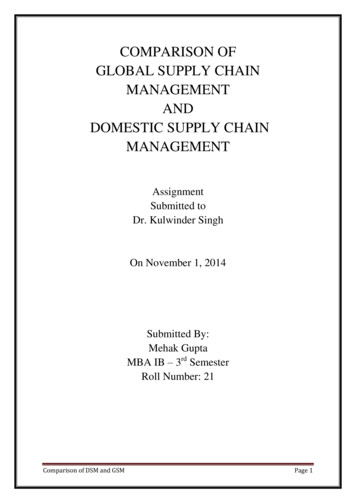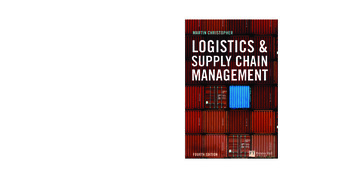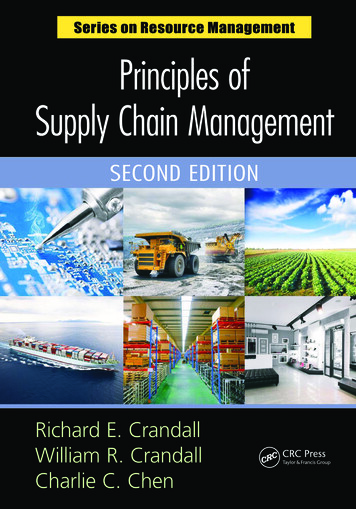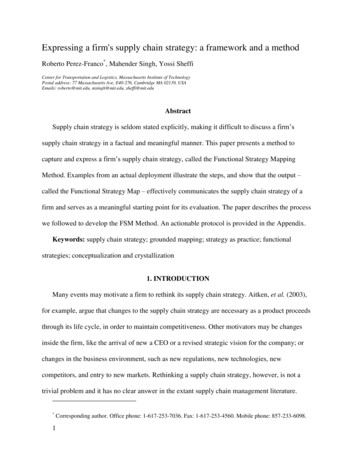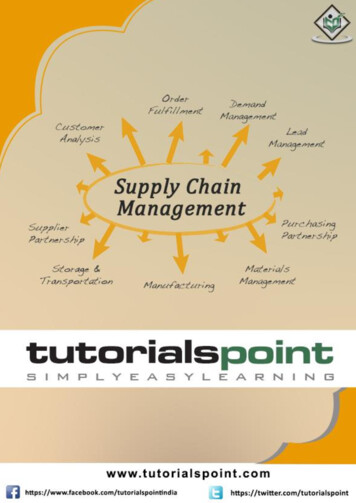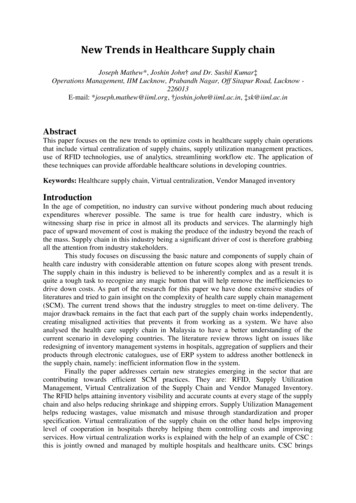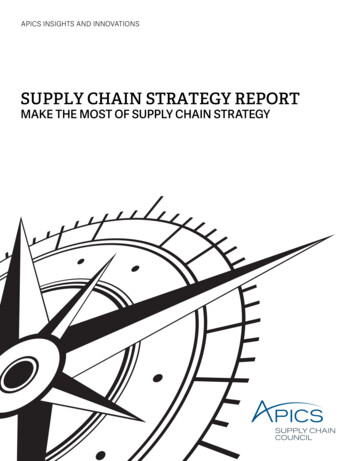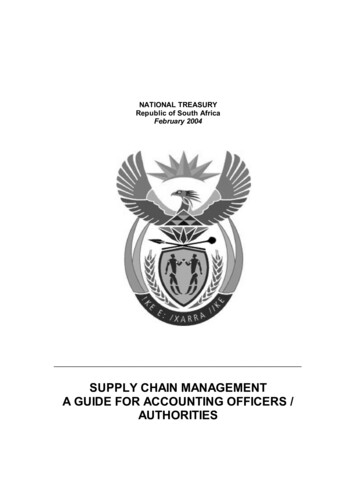
Transcription
NATIONAL TREASURYRepublic of South AfricaFebruary 2004SUPPLY CHAIN MANAGEMENTA GUIDE FOR ACCOUNTING OFFICERS /AUTHORITIES
2PREFACEThis Guide sets out the philosophy behind the adoption of an integratedSupply Chain Management (SCM) function across government and will assiststakeholders to understand the responsibilities this implies. This documentexplains the impact of the changes for accounting officers/authorities at eachstep of the SCM cycle.While the Constitution states that procurement practices must be fair,equitable, transparent, competitive and cost-effective, the present position isfar from the ideal, for example: procurement and provisioning procedures are rule driven, and value formoney is almost always equated to the lowest price tendered - theemphasis is on monitoring inputs; procurement and provisioning activities are not linked to budgetaryplanning; asset management is limited to control of inventory, rather than onensuring a satisfactory return to the community for the funds invested; bid documentation are not uniform, causing uncertainty to bidders andpractitioners; the Preferential Procurement Policy Framework Act, No 5 of 2000(PPPFA) and its associated Regulations are complex and difficult toimplement correctly, and procurement practitioners are not adequatelytrained in their application; the costs and outcomes of the PPPFA are not fully quantified, hence it isimpossible to evaluate the merits of the system.In September 2003, Cabinet adopted a SCM policy to replace the outdatedprocurement and provisioning practices (described above) across governmentwith a SCM function that will be an integral part of financial management andwill conform to international best practices. The new arrangements willpromote uniformity in SCM processes and also in the interpretation ofgovernment’s preferential procurement legislation and policies, which shouldthemselves be seen in the context of other related legislative and policyrequirements. Above all, these arrangements will mean that responsibilityand accountability for SCM-related functions will be devolved to accountingofficers/authorities.The very substantial divide between the current outdated procurement andprovisioning practices in government and the new integrated SCM functionnecessitates a phased implementation approach.This Guide is intended to facilitate a general understanding of the changes toSCM practices.It must be seen as a step to assist accountingofficers/authorities in the smooth implementation of supply chain managementwithin their institutions. The Guide will be supplemented on a regular basis tokeep abreast as the development of the supply chain management functionwithin government progresses.
3An informal approach has been followed to make the Guide as user friendlyas possible. The term “institution” is used throughout the document to refer toall organs of state to whom the policy adopted by Cabinet applies.The Guide is not a substitute for legislation and should not be used for legalinterpretations. Nor does it in any way detract from the responsibilitiesParliament and the legislatures expect all accounting officers/authorities tofulfil in terms of the Public Finance Management Act, 1999 (Act 1 of 1999 asamended by Act 29 of 1999) (PFMA), as well as the Preferential ProcurementPolicy Framework Act, Act 5 of 2000 (PPPFA).
4INDEXPagePREFACE2GLOSSARY AND ABBREVIATIONS7CHAPTER 1 : INTRODUCTIONBackgroundImproving accountabilitySupply chain management: The new policySupply chain management modelThe appointment of consultantsPreferential procurementPromoting uniformity in SCM practicesThe policy context: Related initiatives8891012121214CHAPTER 2 : IMPLEMENTATION STRATEGYIntroductionNational TreasuryTender BoardsProvincial TreasuriesInstitutionSupportTrainingMonitoring and guidanceMedium-term policy issuesIntroductionReviewing the PPPFA and associated RegulationsIntroducing targets based on chartersFraud and corruption17181920202222222222222323CHAPTER 3 : DEMAND MANAGEMENTIntroductionDemand considerationsFlowchart of the demand management processPreferential procurement strategySpecification of goods/works or services2525262727CHAPTER 4 : ACQUISITION MANAGEMENTIntroductionTreasury supportDelegationsAssessment of the marketSourcing strategyEstablishment of a database of suppliers whenobtaining quotationsAcquisitioning processUrgent an emergency cases2828282829293031
5Accommodation and conferencesNegotiations with a supplierLimited biddingTwo-stage biddingCompiling bid documentsInviting bidsReceiving responsesEvaluating responsesClearing successful bidder and awarding contractFlowcharts : Processes for acquisitioning management32323233344144454648CHAPTER 5 : APPOINTMENT OF CONSULTANTSIntroductionApplicability of proceduresAppointment in terms of the Public Service Act, 1994 (Act No103 of 1994)General approachConflict of interestAssociations between consultantsPromoting government’s preferential policiesTraining or transfer of knowledge and skillsSteps to follow when selecting consultantsThe four stages of selectionIdentify the approachInvite bids/proposals, using QCBSRequest for bidsRequest for proposalsReceipt of proposalsEvaluation of bids/proposalsCalculation of percentage for functionalityCalculation of percentage for priceCalculation of points for functionality and priceOther methods of selectionQuality-Based Selection (QBS)Selection under a fixed budgetLeast-cost selectionSelection based on consultants’ qualificationsSingle-source selectionSelection of individual consultantsSelection of particular types of consultantsEstablishment of a list of approved service providersEvaluation of the performance of consultantsTypes of contractsImportant provisionsAdvertising of expected and outstanding procurementInformation to consultants 37475767778798182CHAPTER 6 : LOGISTICS MANAGEMENTIntroductionStock levels86865556
6Placing of ordersOrder processingContract purchaseQuotation/competitive bidding methodVendor performanceStores/warehouse managementIssuing/distribution of itemsStocktakingTransport managementAccounts ER 7 : DISPOSAL MANAGEMENTIntroductionAssets accruing to the state by operation of any law8990CHAPTER 8 : SUPPLY CHAIN PERFORMANCE91Annexure A : General Conditions of Contract92
7GlossaryAccounting AuthorityAccounting OfficersInstitutionAs defined in Section 49 of the PFMAAs defined in Section 36 of the PFMAIn this document, the term is used to mean allconstitutional institutions, public entities asdefined in schedule 3A & 3C of the PFMA,national and provincial departments, tradingentities and all school governing SBDSCCSCMSCOPASITASMMEBlack Economic EmpowermentBroad-Based Black Economic EmpowermentChief Financial OfficerConstruction Industry Development BoardDepartment of Trade and IndustryGeneral Conditions of ContractHistorically Disadvantaged IndividualInstitute for Public Finance and AuditingNew Partnership for Africa’s DevelopmentNational Industrial Participation ProgrammeNational Small Business CouncilPublic Finance Management ActPreferential Procurement Policy Framework ActPublic Service ActReconstruction and Development ProgrammeSouth African Institute for Chartered AccountantsSouth African Local Government AssociationSouth African Management Development InstituteSouth African National Accreditation SystemSouth African Revenue ServicesStandard Bidding DocumentSpecial Conditions of ContractSupply Chain ManagementStanding Committee on Public AccountsState Information Technology AgencySmall, Medium and Micro Enterprise
81Introduction1.1Background1.1.1Government is intent on modernising the management of thepublic sector, to make it more people-friendly and sensitive tomeeting the needs of the communities it serves. Immediately ontaking office in 1994, Government initiated a series of budgetaryand financial reforms. Since then, significant progress has beenmade in implementing these reforms.1.1.2A basic principle is that managers should be given the flexibility tomanage, within a framework that satisfies the constitutionalrequirements of transparency and accountability. There are manyobstacles to overcome, most notably, a series of deeply ingrainedpractices. The facade of control imposed by the former verydetailed Treasury Instructions was an illusion, and in factaccountability was undermined, as departments were required toobtain ‘approval’ from Treasury for example, to ‘write-off’ minordebts. Another obstacle can be seen in the cumbersomeprocurement processes, where the legislation empowered TenderBoards to determine the award of contracts: thus an accountingofficer/authority may well have had to accept responsibility fordelays caused by Tender Board procedures.1.2Improving accountability1.2.1The PFMA aims to improve accountability by placing responsibilityfor decisions in the hands of each accounting officer/authority, andby ensuring that there is a framework of support from NationalTreasury, for example, in the form of ‘best practice’ guidelines, toassist managers in delivering services to communities asefficiently and effectively as possible.1.2.2The accountability chain is the most critical driver for improvingfinancial management in the public sector. The Annual Reportand the report of the Auditor-General will indicate achievementagainst the intentions specified in each department’s strategicplan and may highlight areas that require improvement. Anaccounting officer/authority who fails to implement the measuressuggested in Guideline documents (such as this one) may bepersonally liable in the event of scrutiny by the StandingCommittee on Public Accounts (SCOPA) or the ProvincialAccounts Committee.1.2.3A particular requirement of the PFMA is that each accountingofficer/authority undertakes a ‘risk assessment’ for his or her
9institution. Risk management acknowledges that all the activitiesof an institution involve some element of risk. Managementshould decide what is an acceptable level of risk (given cost andother social factors) by objectively assessing the factors (risks)that may prevent a particular activity from meeting its objective. Inthe case of SCM, this will include ensuring – on a case-by-casebasis – that risks such as price or currency fluctuations areallocated to the appropriate party in unambiguous contractdocuments or that guarantees or insurance arrangements are inplace (managers must manage!).1.2.4In addition, the award and management of contracts iswhere fraud and corruption has been found in the pastinstitution’s Fraud Prevention Plan should reflect this,cost-effective use of control measures and proceduresethical culture.an areaand thethroughand an1.2.5The PFMA assigns considerable powers to accountingofficers/authorities to enable them to manage their financial affairswithin the parameters laid down by prescribed norms andstandards. To this end, Cabinet resolved that the concept ofSupply Chain Management be introduced within the public sector.These reform measures are summarised below.1.3Supply Chain Management: the new policy1.3.1There are four major objectives in the policy adopted by Cabinet.These are to:Transform government procurement and provisioning practicesinto an integrated SCM function;Introduce a systematic approach for the appointment ofconsultants;Create a common understanding and interpretation of thepreferential procurement policy; andPromote the consistent application of ‘best practices’throughout government’s supply chain.1.3.2The supply chain function1.3.2.1The introduction of an integrated SCM function will address theinefficiencies in government’s current method of procurement,contract management, inventory/asset control and obsolescenceplanning. The integrated SCM function, where value is added atevery stage, is shown in the diagram below.
10SUPPLY CHAIN MANAGEMENT MODELElements of supply chain managementSUPPLY CHAIN �SPREFERENTIALPROCUREMENTPOLICY OBJECTIVESINFRASTRUCTURE(SYSTEMS)DEMANDSUPPLY CHAIN PERFORMANCEDATABASE/S1.3.2.2The elements of SCM are summarized below and an explanationof the detailed application of each is contained in subsequentchapters of this Guide.Demand Management: This is the beginning of the supplychain where: a needs assessment to ensure that goods or services areacquired in order to deliver the agreed service is done;specifications are precisely determined;requirements are linked to the budget; andthe supplying industry has been analysed.This phase will bring the supply chain practitioner close to theend user, to ensure that value for money is achieved.
11Acquisitioning Management: Traditionally, almost all the focusof procurement activity has been given to this stage (to thealmost total exclusion of the other aspects of SCM). Themanagement, rather than purely procedural considerationsare: to decide on the manner in which the market will beapproached; to establish the total cost of ownership of a particular type ofasset; to ensure that bid documentation is complete, includingevaluation criteria; to evaluate bids in accordance with published criteria; and to ensure that proper contract documents are signed.Logistics Management: This aspect addresses: the setting of inventory levels;receiving and distribution of material;stores, warehouse and transport management; andthe review of vendor performance.From these processes, the financial system should be activatedto generate payments.Disposal Management: At this stage consideration should begiven to: obsolescence planning;maintaining a data base of redundant material;inspecting material for potential re-use;determining a disposal strategy; andexecuting the physical disposal process.Supply Chain Performance: This is a monitoring process,undertaking a retrospective analysis to determine whether theproper processes have been followed and whether the desiredobjectives were achieved. Some of the issues that may bereviewed are: 1.3.2.3compliance to norms and standards;cost efficiency of SCM process (i.e. the cost of the processitself); andwhether supply chain practices are consistent withGovernment’s broader policy focus.This SCM policy applies to the acquisition and disposal of allgoods, services, construction and road works and movableproperty of all institutions and all school governing bodies,
12whether or not they have been assigned additional responsibilitiesin terms of section 21 of the South African Schools Act, 1996.1.3.2.4The acquisition and disposal of immovable property is regulated interms of the Land Affairs Act and administered by the Departmentof Public Works.1.3.2.5The National Treasury has published a regulatory framework interms of the PFMA to prescribe minimum norms and standards forSCM practices in Government. This will establish minimumreporting requirements for accounting officers/authorities that willenable the National Treasury to report progress to Cabinet oncompliance as well as policy outcomes.1.4The appointment of consultants1.4.1Government makes considerable use of consultants from variousdisciplines and there are minimum requirements of quality andefficiency to be achieved when appointing them. It is necessary toimpose measures to ensure that consultancy assignments areexecuted in such a way that the ethical principles of the relevantprofession are met at all times. This includes ensuring that advicereceived is unbiased, i.e., free from any affiliation, economic orotherwise, which may cause conflict between the consultant’sinterests and those of Government. Hence a new approach hasbeen defined which is set out in Chapter 5 of these guidelines.1.5Preferential procurement1.5.1The Preferential Procurement Policy Framework Act 2000 (Act 5of 2000) and its accompanying Regulations were promulgated toprescribe a framework for a preferential procurement system.This Act and its Regulations incorporate the ‘80/20’ and ‘90/10’preference point systems. However, the implementation of thislegislation has not been without problems and Cabinet hasrecently approved the publication of a ‘Broad-Based BlackEconomic Empowerment Bill’, and a supporting strategy, whichwill lead to amendments to the Preferential ProcurementRegulations during the course of 2004. The aim of the intendedamendments to the Regulations is to align the Regulations withthe aims of the Broad Based Black Economic Empowerment Actand its supporting Regulations.1.6Promoting uniformity in SCM practicesUniformity in SCM practices will be promoted in the followingmanner:
131.6.1Bid procedures, policies and control measures1.6.1.1Efficiency and effectiveness in SCM will be improved by applyinga uniform system in all institutions. Bidding procedures shouldbecome easy to interpret, cost effective, inexpensive, quick,transparent and free of corruption.1.6.1.2Accounting officers/authorities should ensure that a formal set ofdelegations is issued to bid evaluation/adjudication committees,which should be constituted of at least three members, of whom atleast one should be a SCM practitioner. When it is deemednecessary, independent experts may also be co-opted to a bidevaluation/adjudication committee in an advisory capacity.1.6.1.3All members of bid adjudication committee(s) should be cleared atthe level of “CONFIDENTIAL” and should be required to declaretheir financial interest annually.1.6.2Contract documentation and contract options1.6.2.1There is a dire need for generic documentation and contractoptions that can be adapted to cater for specific industryrequirements.Bid documents define the rights, risks andobligations of the parties involved in a contract and define thenature, quantity and quality of the goods, services or works to beprovided in the performance of the contract. Accordingly, suchdocumentation should be legally and technically correct andshould assign risk in an appropriate manner.1.6.2.2Bid documents will comprise at least the following: GeneralConditions of Contract; specifications, data sheets/drawings; anda specific contract agreement stipulating delivery standards andrequirements. Uniformity in these documents will promote:Ease of entry by new emerging enterprises to governmentprocurement;Cost effectiveness, both in financial and human resourceterms;Improved understanding and easier interpretation by newemerging contractors; andSimplification of the documentation process.1.6.2.3Uniformity in contract documentation will result in:Bidders being able to more easily determine the scope andextent of risk;Easier management of contracts between potential contractingparties and the streamlining of administrative procedures;Savings in cost and improvement in quality; and
14Greater transparency in terms of cost premiums paid in pursuitof Government’s preferential procurement objectives.1.6.2.4It is imperative that accounting officers/authorities take due carethat standardised bid documents are used for all standardprocurement of goods, works and services. It is the responsibilityof the SCM Office in the National Treasury to issue pro formastandardised bid documentation. In cases where special bidconditions make it necessary to deviate from the standardised biddocumentation, it is advisable for accounting officers/authorities toprovide written approval for such deviations and that themotivation for deviations be documented for auditing purposes.1.7The policy context: Related initiatives1.7.1Government’s supply chain policies and practices impact on abroad range of other policies and regulations and also influencethe economic behaviour of people, both within and outside theborders of the country. It is therefore imperative that procurementreform initiatives remain fully aligned with Government’s broaderpolicy focus and accounting officers/authorities should be awareof:Competition law: Restrictive business practices are regulatedby the Competition Act (89 of 1998), which aims to outlaw anticompetitive practices between businesses, their supplier(s)and customers.This includes price-fixing and collusivebidding;The National Small Business Act, Act No. 102 of 1996: ThisAct establishes the National Small Business Council (NSBC)and also the Ntsika Enterprise Promotion Agency (Ntsika).The main function of Ntsika is to enable small businesses tocompete successfully in the economy;Anticorruption measures and practices: The Constitutionprovides for rights such as just administration and access toinformation and requires high standards of ethics within publicadministration. Recent legislation dealing with transparencyand anti-corruption measures strengthen Government’s abilityto combat corruption and also protects employees makingdisclosures against their employers in both the public andprivate sectors;State Information Technology Agency (SITA) Act, (Act No. 88of 1998, as amended by Act No. 38 of 2002): The Act requiresthat SITA must act as the procurement agency for everydepartment’s information technology requirements. This Actprescribes that all departments are compelled to procure allinformation and technology goods and services through Sita.
15The accountability remains with the accounting officer /authority;Trade policy: Government’s commitment to trade liberalisationshould be reflected in its supply chain practices, by notprecluding foreign companies from bidding for governmentcontracts;Labour issues: As Government subscribes to international bestpractice principles of equitable and fair labour rethatsuppliers/contractors comply with all provisions of Labour Law.Hence any supplier, service provider or contractor who abuseslabour standards, should be designated as ‘non-preferred’.Safety, health and environment: Government is committed tothe highest standards of safety, health and environmentalprotection and promotes a culture of “non tolerance”. Henceoccupational health and safety issues should be considerednot only for employees but also for contractors’ employeesperforming work on site at any institution.Public-Private Partnerships: Whenever goods, works and/orservices are procured by means of public private partnerships,Section 16 of the Treasury Regulations must be adhered to;New partnership for Africa’s development (NEPAD): NEPAD isan initiative to accelerate a new relationship with the highlyindustrialised countries to overcome the widening developmentchasm between them and the African continent.Acommitment is fostered on the part of governments, the privatesector and other institutions of civil society towards themeaningful integration of all nations into the global economyand body politic. This requires the recognition of globalinterdependence in respect of production and demand, theprotection of the environmental base that sustains the planet,reversal of the skills-loss from the continent and a globalfinancial architecture that rewards good socio-economicmanagement and global governance. All SCM practicesshould aim to support these objectives.Black Economic Empowerment (BEE): The definition ofHistorically Disadvantaged Individuals (HDIs) in the PPPFAand its Regulations includes, but is not exclusive to BEE. Thisaspect created considerable confusion amongst both SCMpractitioners and suppliers of goods and services t Act, No. 53 of 2003 which was promulgated inJanuary 2004 will, when enacted, provide that the Minister ofTrade and Industry may, amongst others, develop broad-
16based transformation charters to promote BEE. This Act willrequire revisions to the Regulations of the PPPFA.Proudly South African: The Department of Trade and Industryhas become a key sponsor and strategic partner of the‘Proudly South African’ campaign which encourages SouthAfrican companies to submit interesting and innovativeachievements in the manufacturing field – new products,export achievements, new partnerships and successes andmilestones. The objectives of this campaign should besupported through government’s SCM processes, if and whenopportunities arise.
172Implementation strategy2.1Introduction2.1.1The introduction of the concept of an integrated SCM system forgovernment will contribute significantly towards the improvementof financial management in the broader public sector. At thesame time, it will create a consistent framework for achievingGovernment’s preferential procurement objectives. It should berecognised, however, that the gap between the currentprocurement and provisioning procedures and practices and thosecontemplated in the policy adopted by Cabinet is substantial.Hence a three-phase strategy to move from the current position tothat desired has been devised. These phases can be categorisedas:firstly, the pre-tender board abolition or preparation phase;secondly, the immediate post-tender board abolition or fullimplementation phase;and lastly, the monitoring phase.2.1.2In order to achieve the ideals of good governance and to addressdeficiencies in supply chain management, fundamentalinstitutional reforms will have to be implemented. These reformsneed to promote efficient and effective procurement andprovisioning systems and practices that enable government todeliver the required quality and quantity of services tocommunities. The establishment of uniformity in procedures,policies, documentation and contract options and theimplementation of sound systems of control and accountabilityshould form the cornerstone of institutional reform.2.1.3The policy and the regulatory frameworks will initially apply toconstitutional institutions, public entities as defined in Schedule 3Aand 3C of the PFMA, national and provincial departments and allschool governing bodies. However, when the PPPFA Regulationsare amended to come into line with the Broad-Based BlackEconomic Empowerment Act, the provisions may also includeother listed public entities identified by the Minister. Until suchtime as the Act and Regulations are amended, accountingofficers/authorities will be required to continue to implement thecurrent requirements.2.1.4The approved policy envisages a cascading set of documents,structured as follows:A Framework for SCM to be issued in terms of the PFMA;
18National Treasury Guide for SCM to be issued, mainly directedat national accounting officers/authorities to assist them infulfilling their obligations;Provincial Treasury Instructions and Guidelines directed atprovincial accounting officers/authorities, ensuring fulfilment oftheir responsibilities in the Provincial sphere;Accounting officers’ directives/procedures, in terms of section38 of the PMFA; andAccounting authority standards issued in terms of section 51 ofthe PFMA to enable them to fulfil their fiduciary responsibilities.The sections below highlight the impact on each of thestakeholders in the SCM process.2.2National Treasury2.2.1To make sure that all treasuries are acting in unison, the NationalTreasury, as with the implementation of the PFMA, will draw up achecklist to make sure that all relevant aspects are addressed andwill also monitor the process of phased implementation to ensuresuccess.2.2.2A provision has been included in the PFMA amendment Bill torepeal the National State Tender Board Act, thus allowingimplementation to proceed. Furthermore, the State Tender BoardRegulations have been amended by means of a promulgation inthe Government Gazette to allow accounting officers of nationaldepartments to procure goods and services either through theState Tender Board (until the State Tender Board Act has beenrepealed) or alternatively in terms of the PFMA.2.2.3The National Treasury will issue a limited number of practicenotes in terms of the framework to guide uniformity in practicesand procedures in the different spheres of government whilstprovincial treasuries will issue further practice notes in acascading fashion to guide the more detailed implementation ofSCM functions.2.2.4A SCM Office has been established in the National Treasury tooversee the implementation of the SCM policy, in conjunction withprovincial treasuries. Its main functions are to:(i) Formulate and advise on SCM policy;(ii) Administer national procurement legislation and regulations;(iii) Promote communications and liaison between different SCMunits;(iv) Monitor the performance of SCM Units at national, provincialand local government level;(v) Serve as a linkage between national government and theSCM units located in institutions;
19(vi) Issue regulations to ensure uniform application of thenational SCM policy, including:(a) Addressing the requirement for consistency with otherpolicy initiatives in government;(b) Ensuring that material construction standards becomeincreasingly aligned with those standards that supportinternational best practice;(c) Establishing selection standards for the appointment ofconsultants;(d) Observing the principles of co-operative governance asexpounded in the Constitution; and(e) Promoting the policy objectives outlined in the PPPFAand accompanying Regulations;(vii) Establish minimum reporting requirements for accountingofficers/authorities;(viii) Investigate complaints received from the public regarding bidprocedures and irregularities;(ix) Maintain a database of non-preferred suppliers;(x) Monitor the manner in which policy is implemented in respectof government’s procurement reform objectives, the mannerin which targets are set and attained, value for moneyobtained and delivery mechanisms; and(xi) Facilitate the arrangement of transversal contracts, providedthat they are cost-effective.2.2.5The National Treasury, in conjunction with the Department ofTrade and Industry is in the process of aligning the PreferentialProcurement Regulations, 2001 with the
the case of SCM, this will include ensuring – on a case-by-case basis – that risks such as price or currency fluctuations are allocated to the appropriate party in unambiguous contract documents or that guarantees or insurance arrangements are in place (managers must manage!). 1.2.4 In a


